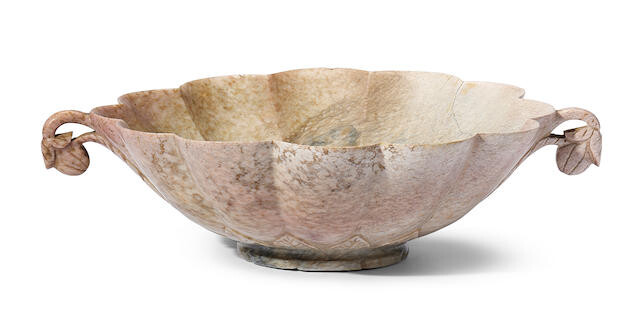A MUGHAL-STYLE CALCIFIED JADE FLORAL BOWL
17th/18th century
17th/18th century
The eight-lobed body rising from a foot formed as an eight-petalled flowerhead underneath high-relief leaves, the sides flanked by a pair of scrolling terminals in the form of pendent buds borne on leafy stems, the stone of opaque pale greyish-white tone with dark grey and brown mottling and some russet colouring, box.
20.2cm (8in) diam. (2).
十七/十八世紀 痕都斯坦式雞骨白玉雕花瓣碗
Provenance:
Jacques Poberejsky (1885-1949), New York
Parke Bernet Galleries, New York, 17 May 1945, lot 99
來源:
紐約Jacques Poberejsky (1885-1949)舊藏
紐約 Parke Bernet Galleries, 1945年5月17日,拍品編號99
The present lot with its lobed form and the decoration of acanthus leaves shows the distinct influence of Mughal jades on Chinese Imperial jade carving. This was due to the favour shown by the Qianlong emperor to such jades which he termed 'Hindustan' jades.
The archaic-revival character of the bowl is evident in features such as the 'burnt' finish of the jade known as the "chicken-bone" jade. This bowl perfectly catered to the Qianlong emperor's own taste of combining classical archaism with foreign 'Hindustani' influences.
See a closely related Mughal pale green jade floral-form bowl in the National Palace Museum, illustrated in Exquisite Beauty – Islamic Jades, Taipei, 2007, pl.59, p.68, showing very similarly decorated handles and the same lobbed form.
碗身雕作十二花瓣形,兩側雕鏤空花苞形耳,下隨淺浮雕莨苕紋,下腹斜收於八出罌粟花瓣形圈足,下腹淺浮雕葉片一周,碗底雕作花瓣形,玉作雞骨白,古雅可愛。
乾隆征服新疆回部之後打開了玉路,除了原料源源不斷流往中土之外,中東及南亞的玉器亦隨之流入內廷,乾隆一併稱之為「痕都斯坦」玉,名重一時。上有所好,下必隨之,蘇州玉工亦開始雕琢類似風格的玉器,然而卻會加入中國特有的風格,如此件拍品之雞骨白,便是典型中國文人所好的仿古舊玉質感;且中國工匠雕琢西方特有的莨苕、罌粟花卉紋時,線條不如原產地之圓潤豐滿,而有古拙之味。
可比較台北故宮藏蒙兀兒帝國製花口花蕾形雙柄碗,其風格裝飾與本件拍品雖為一路,然本件之線條與用刀終究充滿了中式意趣,見鄧淑萍編,《國色天香—伊斯蘭玉器》,台北,2007年,圖版59,頁68。
View it on
Sale price
Estimate
Time, Location
Auction House
17th/18th century
17th/18th century
The eight-lobed body rising from a foot formed as an eight-petalled flowerhead underneath high-relief leaves, the sides flanked by a pair of scrolling terminals in the form of pendent buds borne on leafy stems, the stone of opaque pale greyish-white tone with dark grey and brown mottling and some russet colouring, box.
20.2cm (8in) diam. (2).
十七/十八世紀 痕都斯坦式雞骨白玉雕花瓣碗
Provenance:
Jacques Poberejsky (1885-1949), New York
Parke Bernet Galleries, New York, 17 May 1945, lot 99
來源:
紐約Jacques Poberejsky (1885-1949)舊藏
紐約 Parke Bernet Galleries, 1945年5月17日,拍品編號99
The present lot with its lobed form and the decoration of acanthus leaves shows the distinct influence of Mughal jades on Chinese Imperial jade carving. This was due to the favour shown by the Qianlong emperor to such jades which he termed 'Hindustan' jades.
The archaic-revival character of the bowl is evident in features such as the 'burnt' finish of the jade known as the "chicken-bone" jade. This bowl perfectly catered to the Qianlong emperor's own taste of combining classical archaism with foreign 'Hindustani' influences.
See a closely related Mughal pale green jade floral-form bowl in the National Palace Museum, illustrated in Exquisite Beauty – Islamic Jades, Taipei, 2007, pl.59, p.68, showing very similarly decorated handles and the same lobbed form.
碗身雕作十二花瓣形,兩側雕鏤空花苞形耳,下隨淺浮雕莨苕紋,下腹斜收於八出罌粟花瓣形圈足,下腹淺浮雕葉片一周,碗底雕作花瓣形,玉作雞骨白,古雅可愛。
乾隆征服新疆回部之後打開了玉路,除了原料源源不斷流往中土之外,中東及南亞的玉器亦隨之流入內廷,乾隆一併稱之為「痕都斯坦」玉,名重一時。上有所好,下必隨之,蘇州玉工亦開始雕琢類似風格的玉器,然而卻會加入中國特有的風格,如此件拍品之雞骨白,便是典型中國文人所好的仿古舊玉質感;且中國工匠雕琢西方特有的莨苕、罌粟花卉紋時,線條不如原產地之圓潤豐滿,而有古拙之味。
可比較台北故宮藏蒙兀兒帝國製花口花蕾形雙柄碗,其風格裝飾與本件拍品雖為一路,然本件之線條與用刀終究充滿了中式意趣,見鄧淑萍編,《國色天香—伊斯蘭玉器》,台北,2007年,圖版59,頁68。



